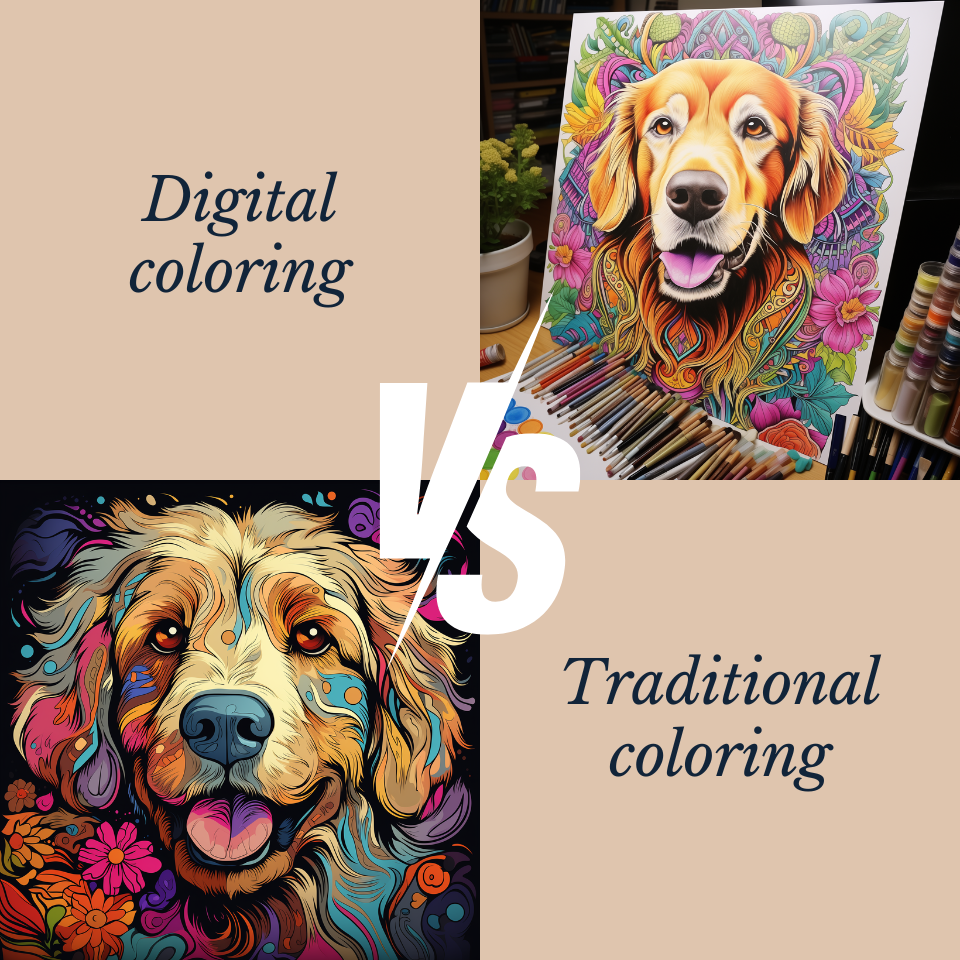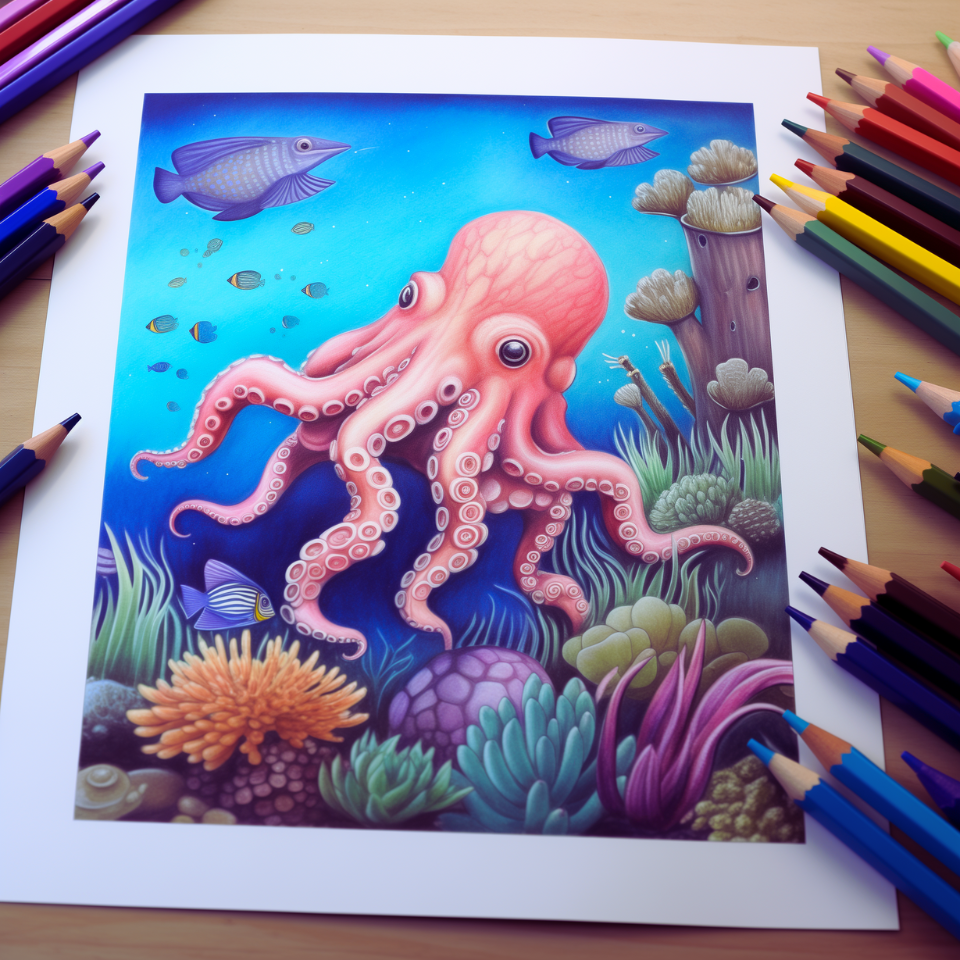Coloring has evolved dramatically in recent years. What was once an activity exclusive to physical books and crayons has now expanded into the digital realm, offering users the chance to color on tablets, phones, and computers. Whether you’re a child who loves scribbling with crayons or an adult using coloring as a form of relaxation, the choice between digital and traditional coloring can be a tough one. Both methods have their advantages and challenges, and the best choice largely depends on what you’re looking for in your creative experience.
Table of Contents

Traditional Coloring: Pros and Cons
Traditional coloring, using crayons, colored pencils, or markers on paper, has been a staple of creative expression for decades. While it offers a hands-on, sensory-rich experience, it also comes with certain limitations.
1. Pros of Traditional Coloring
Physical Connection to the Art
One of the greatest benefits of traditional coloring is the direct, tactile connection you have to the artwork. Holding a crayon, pencil, or marker and feeling the texture of paper beneath your fingers creates a physical experience that many find deeply satisfying. This hands-on approach engages multiple senses and makes coloring feel more personal.
Sensory Experience and Nostalgia
Traditional coloring has a distinct nostalgic charm. Many adults recall childhood memories of sitting down with a coloring book and a box of crayons. The smell of a freshly opened box of Crayola crayons or the feel of shading with colored pencils brings back warm, familiar feelings that digital coloring simply can’t replicate.
Wide Variety of Mediums and Textures
From watercolor pencils to oil pastels, traditional coloring offers an enormous variety of mediums to explore. Each tool produces a different texture, which can add depth and dimension to your artwork. You can experiment with blending colors or layering different mediums to achieve unique results.
2. Cons of Traditional Coloring
Costs of Materials
Traditional coloring requires a constant supply of materials — coloring books, crayons, pencils, markers, and paper. Over time, these costs can add up, especially if you enjoy working with higher-quality art supplies. Replacing expensive markers or restocking on art supplies can be a considerable investment.
Limited Flexibility for Mistakes
Once you put color on paper, it’s often difficult or impossible to undo mistakes. Unlike digital coloring, where you can easily “undo” or erase an error with the click of a button, traditional coloring requires extra care. Mistakes made in marker or pen can be especially tricky to fix, and coloring outside the lines is a common frustration.
Space and Storage Considerations
Traditional coloring requires physical space. You need a place to store your supplies and completed works. If you’re a frequent colorist, you may find yourself accumulating piles of coloring books, art supplies, and stacks of colored pages. For those with limited space, this can be a challenge.

Digital Coloring: Pros and Cons
Digital coloring has opened up a new world of possibilities for artists and hobbyists. Using apps and digital tools, you can color on a tablet or computer, enjoying benefits that traditional methods can’t offer.
1. Pros of Digital Coloring
Unlimited Color Choices and Flexibility
With digital coloring, you’re not limited by the number of crayons or colored pencils in your box. Most apps provide an infinite range of colors and shades, allowing you to experiment freely with different hues and blends. Digital platforms also offer tools like opacity adjustments, gradients, and patterns that would be difficult or impossible to achieve in traditional coloring.
Ability to Undo Mistakes Easily
One of the most significant advantages of digital coloring is the ability to undo mistakes. If you make an error, simply click “undo” or erase it without damaging the overall piece. This freedom allows you to experiment with different styles and techniques without the fear of permanent mistakes, encouraging a more relaxed creative process.
Portability and Convenience
A tablet or smartphone makes digital coloring highly portable. You can take your coloring with you anywhere, without needing to lug around paper, coloring books, and art supplies. All your tools are contained within one device, making it an ideal option for traveling or coloring on-the-go. Additionally, you can easily save and share your work digitally.
2. Cons of Digital Coloring
Screen-Related Health Issues
One downside to digital coloring is the amount of time spent in front of a screen. Prolonged screen time can lead to issues like eye strain, headaches, and disrupted sleep patterns due to exposure to blue light. This is particularly concerning for children who already spend significant time using digital devices.
Lack of Tactile Feedback
While digital coloring offers convenience, it lacks the tactile experience of traditional coloring. There’s no physical interaction with paper or pencils, which can make the creative process feel less immersive for some people. The absence of texture, the feel of paper, and the sensory satisfaction of coloring with traditional tools are hard to replicate on a digital screen.
Learning Curve and Tech Limitations
Digital coloring apps can be complex and may require a learning curve, particularly for those who are less tech-savvy. Additionally, not all devices are created equal — some tablets or smartphones may not support advanced drawing features, and not everyone has access to the best styluses or software for a seamless coloring experience.

Comparing the Creative Experience
The act of coloring — whether digital or traditional — is deeply personal and can vary depending on what you’re seeking in terms of creativity and engagement.
1. Immersion and Focus
Traditional Coloring and Mindfulness
Many people find that traditional coloring allows for greater mindfulness. The slow, deliberate motions of filling in spaces with color help engage the mind in a meditative, calming way. It’s an analog escape from digital life, promoting relaxation and focus.
Digital Coloring’s Rapid Experimentation
On the other hand, digital coloring offers more rapid experimentation. You can test colors, erase and redo sections, or change designs easily, encouraging creative exploration without worrying about “ruining” a piece. This speed and flexibility are appealing to those who prefer a more dynamic approach.
2. Precision and Versatility
Traditional Mediums vs. Digital Editing Tools
While traditional mediums allow for precision in blending and shading with physical tools, digital coloring gives users access to advanced editing tools like zooming in for detail work or adjusting color schemes with a few clicks. This makes digital coloring highly versatile, allowing users to correct or tweak elements without starting over.

Environmental and Practical Considerations
Beyond the creative experience, both traditional and digital coloring have practical implications for the environment and accessibility.
1. Sustainability: Digital vs. Paper
Environmental Impact of Traditional Materials
Traditional coloring, particularly if you go through lots of paper or plastic-based markers, has an environmental cost. Paper production, packaging, and the disposal of art supplies can contribute to waste, making it less sustainable for frequent users.
Digital Coloring’s Energy Consumption
While digital coloring avoids the use of paper and physical materials, it does come with its own environmental footprint. The energy consumption of tablets and other electronic devices, along with the mining and manufacturing of electronics, can also have an ecological impact.
2. Accessibility and Affordability
Costs of Digital Tools vs. Traditional Supplies
While traditional coloring requires ongoing purchases of supplies, the cost of digital tools like tablets and styluses can be higher upfront. However, digital coloring apps are often inexpensive or free, and the tools can last for years without the need for replacement.
Accessibility for Various Age Groups
Traditional coloring is typically easier for younger children and older adults who may struggle with technology. However, digital coloring offers accessibility options like zooming for precision or tools that can assist those with physical limitations.
Conclusion
Both digital and traditional coloring offer unique advantages, and the choice between them depends on personal preferences and needs. Traditional coloring provides a tactile, nostalgic experience, while digital coloring opens up endless possibilities for creativity and experimentation. Whether you prefer the hands-on satisfaction of paper and pencils or the convenience and flexibility of a tablet, there’s no wrong way to enjoy coloring. The best method is the one that helps you relax, create, and express yourself.